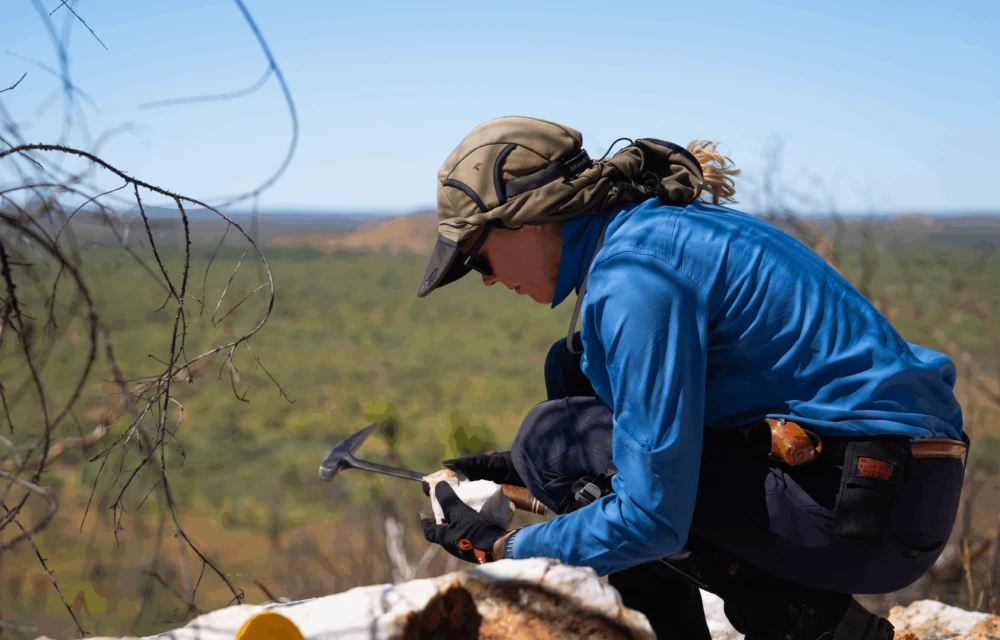Data reveals what drilling can’t: How Geoscience Australia is mapping the hidden rare earth riches buried beneath Australia’s ancient landscapes


, , , , , , ,
, , , ,
It’s not often a map redraws itself — but that’s exactly what’s happening to Australia’s rare earths landscape. At the Critical Minerals Conference 2025 in Perth, Dr Jessica Walsh, Project Leader of the Accelerating Development of Australia’s Rare Earth Resources (ADARER) project at Geoscience Australia, revealed that new data-driven modelling is uncovering entire regions of previously unrecognised potential for clay-hosted rare earth element (REE) systems.
Jessica’s paper, “A national-scale assessment of clay-hosted rare earth element mineral system potential in Australia,” co-authored with Andrew McPherson, Emily Oborski, Anthony Senior, Jonathan Cloutier, and Arianne Ford, outlined how her team is applying a hybrid knowledge- and data-driven methodology to build a national-scale predictive model for REE mineral systems.
Seeing what’s been hidden
“The transition to net zero has accelerated global demand for critical minerals, particularly rare earth elements,” Jessica said. “But while clay-hosted REE deposits represent some of the world’s most strategically important resources, their distribution and potential in Australia haven’t been fully understood — until now.”
Rather than focusing on known deposits, Jessica’s team took a broader view, integrating pre-competitive datasets across geology, geochemistry, and geophysics to statistically map the conditions that favour the development of clay-hosted REE systems. “We’re not trying to pinpoint single deposits,” she explained. “We’re identifying the geological environments where those deposits are most likely to occur.”
By combining mineral systems science with spatial analytics and machine learning, the project is revealing patterns invisible to traditional exploration methods. “This approach lets us predict areas with high geological potential for clay-hosted REEs — even in regions where no deposits have been recorded,” Jessica said.

Data, science, and serendipity
The study forms part of the Australian Critical Minerals Research and Development Hub, a collaboration between Geoscience Australia, CSIRO, and ANSTO, with ANSTO as lead partner. Its mandate: to boost Australia’s discovery pipeline for critical minerals through innovation in mineral systems research.
Jessica’s team has shown how integrating pre-competitive datasets — from regolith geochemistry to satellite spectral data — can statistically define “favourable conditions” for REE enrichment. “By testing geological hypotheses at a continental scale, we’re able to validate the processes that control how and where these deposits form,” she said. “The goal is to de-risk early-stage exploration and reduce the search space for industry.”
The model’s predictive capability has already been benchmarked against known deposits, successfully identifying regions of known mineralisation while flagging new, unexplored targets across multiple states. The result is a national-scale mineral potential map that can guide both explorers and policymakers.
From national science to practical exploration
For exploration professionals, the implications are significant. Jessica’s work gives explorers a scientifically defensible framework to prioritise targets — one that moves beyond intuition and isolated datasets. “Our aim is to improve exploration efficiency,” she said. “If we can help companies focus their efforts where the geology makes sense, we accelerate discovery while reducing cost and environmental footprint.”
The study also supports Australia’s broader ambition to secure its position in the global rare earth supply chain by identifying low-impact, high-value resources that can underpin long-term supply. Clay-hosted systems, in particular, offer advantages for processing and sustainability, making them a critical part of Australia’s clean energy strategy.
The next frontier
For Jessica, this research is about more than mapping geology — it’s about reimagining exploration itself. “We’re combining geoscience expertise with data analytics to bridge the gap between what’s known and what’s possible,” she said. “The future of discovery in Australia lies in connecting those dots — literally.”
In short: Dr Jessica Walsh and her team at Geoscience Australia are turning invisible geology into visible opportunity, proving that when it comes to rare earths, the smartest exploration tools might not be a drill rig — but a data model.
